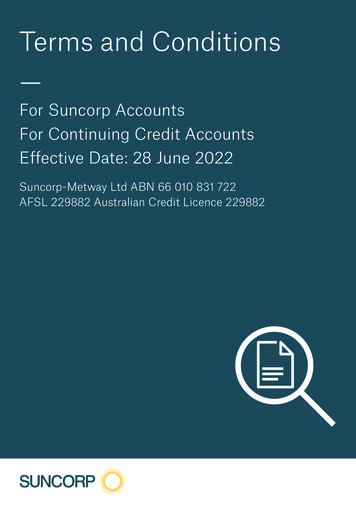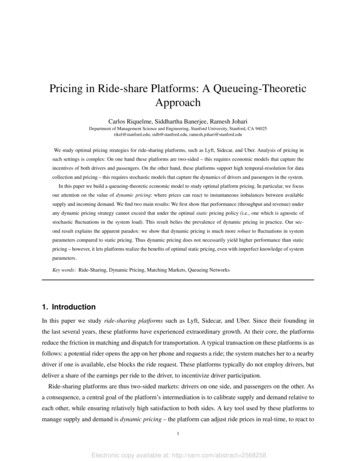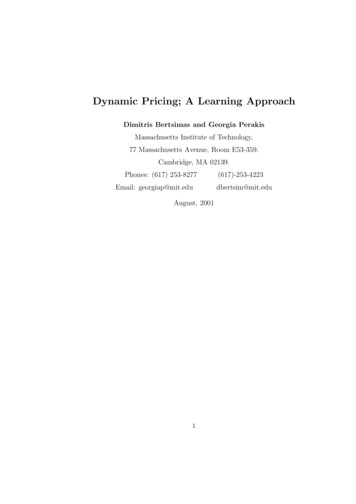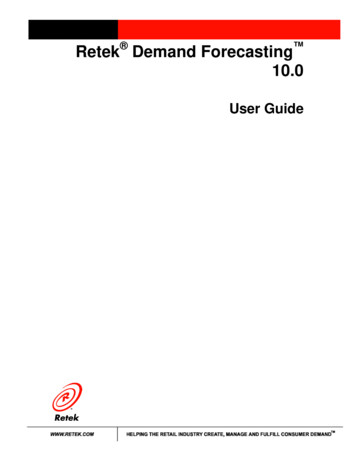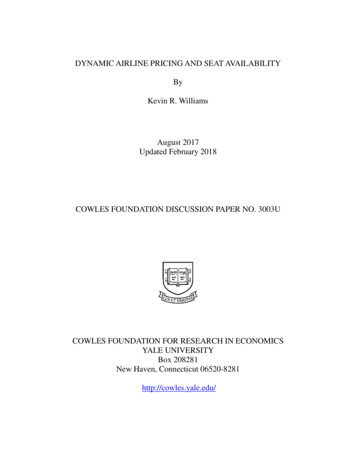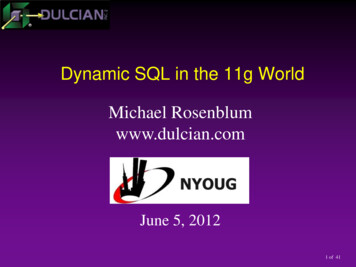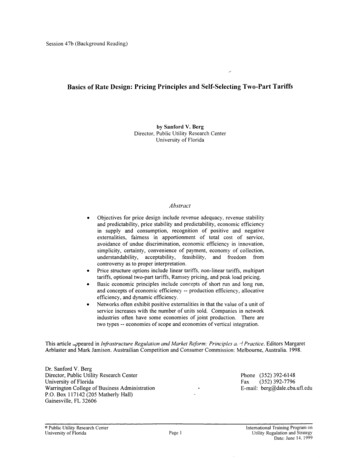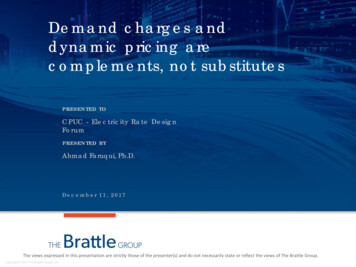
Transcription
Demand charges anddynamic pricing arecomplements, not substitutesPRESENTED TOCPUC - Electricity Rate DesignForumPRESENTED BYAhmad Faruqui, Ph.D.December 11, 2017The views expressed in this presentation are strictly those of the presenter(s) and do not necessarily state or reflect the views of The Brattle Group.Copyright 2017 The Brattle Group, Inc.
Electricity has a capacity component and anenergy componentWhen customers connect to the grid, they buy a 24/7 call option onthe grid (which consists of power plants, transmission lines,substations, feeders, transformers, meters, and electric wires).Even if customers consume no energy during the peak period, theyshould still pay for being connected to the grid.That is where a connection charge, or a non-coincident demandcharge enters into the picture.The views expressed in this presentation are strictly those of the presenter(s) and do not necessarily state or reflect the views of The Brattle Group.CPUC - Electricity Rate Design Forum1 brattle.com
Moving forward with tariff reformThere is no easy way to differentiate fixed charges by customer size.Non-coincident demand charges provide a more feasible option.Energy can be priced dynamically, but grid costs are best recoveredthrough demand charges.Smart meters have been around for a long time for large customers;their presence does not alter the principles of rate design.I will share some examples of real-time pricing programs for largecustomers tomorrow; they include both demand charges and dynamicpricing.The views expressed in this presentation are strictly those of the presenter(s) and do not necessarily state or reflect the views of The Brattle Group.CPUC - Electricity Rate Design Forum2 brattle.com
Primary ReferencesFaruqui, Ahmad and Mariko Geronimo Aydin, “Moving Forward with Electric TariffReform,” Regulation, Fall pdfFaruqui, Ahmad, “Innovations in Pricing,” Electric Perspectives, September/October 2017.https://mydigimag.rrd.com/publication/?i 435343&ver html5&p 42#{"page":42,"issue id":435343}Faruqui, Ahmad and Henna Trewn, “Enhancing Customer-Centricity,” Public UtilitiesFortnightly, August 08/enhancing-customer-centricityFaruqui, Ahmad and Henna Trewn, “Rethinking Customer Research in the Utility Industry,”Public Utilities Fortnightly, July 07/rethinking-customer-researchFaruqui, Ahmad, Wade Davis, Josephine Duh, and Cody Warner, "Curating the Future ofRate Design for Residential Customers," Electricity Daily, stomersThe views expressed in this presentation are strictly those of the presenter(s) and do not necessarily state or reflect the views of The Brattle Group.CPUC - Electricity Rate Design Forum3 brattle.com
Secondary References“The Impact of Time-of-Use Rates in Ontario,” with Neil Lessem, Sanem Sergici, and DeanMountain, Public Utilities Fortnightly, February 02/impact-time-use-rates-ontario“Dynamic pricing works in a hot, humid climate: evidence from Florida,” with Neil Lessemand Sanem Sergici, Public Utilities Fortnightly, May 05/dynamic-pricing-works-hot-humidclimateFaruqui, Ahmad, Toby Brown and Lea Grausz, “Efficient Tariff Structures for DistributionNetwork Services,” Economic Analysis and Policy, pii/S0313592615300552Faruqui, Ahmad, Ryan Hledik and Neil Lessem, “Smart By Default,” Public UtilitiesFortnightly, August 8/smartdefault?page 0%2C0&authkey a08a8abd39c54dFaruqui, Ahmad, Sanem Sergici and Lamine Akaba, “Dynamic Pricing in a ModerateClimate: The Evidence from Connecticut,” Energy Journal, 35:1, pp. 137-160, January 2014.The views expressed in this presentation are strictly those of the presenter(s) and do not necessarily state or reflect the views of The Brattle Group.CPUC - Electricity Rate Design Forum4 brattle.com
Secondary References IIFaruqui, Ahmad and Sanem Sergici, “Arcturus: International Evidence on Dynamic Pricing,”The Electricity Journal, 26:7, August/September 2013, pp. /pii/S1040619013001656Faruqui, Ahmad, Sanem Sergici, and Lamine Akaba, “Dynamic Pricing of Electricity forResidential Customers: The Evidence from Michigan,” Energy Efficiency, 6:3, August 2013,pp. 571–584.Faruqui, Ahmad, Ryan Hledik, and Jennifer Palmer, Time-Varying and Dynamic RateDesign. Global Power Best Practice Series, The Regulatory Assistance Project (RAP), 2012.Faruqui, Ahmad and Jennifer Palmer, “Dynamic Pricing of Electricity and its Discontents,”Regulation, Volume 34, Number 3, Fall 2011, pp. /regv34n3-5.pdfFaruqui, Ahmad and Sanem Sergici, “Dynamic pricing of electricity in the mid-Atlanticregion: econometric results from the Baltimore gas and electric company experiment,”Journal of Regulatory Economics, 40:1, August 2011, pp. 82-109.The views expressed in this presentation are strictly those of the presenter(s) and do not necessarily state or reflect the views of The Brattle Group.CPUC - Electricity Rate Design Forum5 brattle.com
Secondary References IIIFaruqui, Ahmad and Jackalyne Pfannenstiel, “California: Mandating Demand Response,”Public Utilities Fortnightly, January 2008, pp. 48-53.http://www.fortnightly.com/display pdf.cfm?id 01012008 MandatingDemandResponse.p dfFaruqui, Ahmad and Stephen S. George, “Quantifying Customer Response to DynamicPricing,” Electricity Journal, May 2005.Faruqui, Ahmad, William D. Bandt, Tom Campbell, Carl Danner, Harold Demsetz, Paul R.Kleindorfer, Robert Z. Lawrence, David Levine, Phil McLeod, Robert Michaels, Shmuel S.Oren, Jim Ratliff, John G. Riley, Richard Rumelt, Vernon L. Smith, Pablo Spiller, JamesSweeney, David Teece, Philip Verleger, Mitch Wilk, and Oliver Williamson, “2003 Manifestoon the California Electricity Crisis,” May tract.php?pid 341Faruqui, Ahmad, Hung-po Chao, Vic Niemeyer, Jeremy Platt, and Karl Stahlkopf, “AnalyzingCalifornia's Power Crisis,” The Energy Journal 22, no. 4 (2001): 29–52.Faruqui, Ahmad and J. Robert Malko, “Residential Demand for Electricity by Time-of-Use: ASurvey of Twelve Experiments with Peak Load Pricing,” Energy 8, no. 10 (1983): 781–795.The views expressed in this presentation are strictly those of the presenter(s) and do not necessarily state or reflect the views of The Brattle Group.CPUC - Electricity Rate Design Forum6 brattle.com
Presenter InformationAHMAD FARUQUI, PH.D.Principal San Francisco, CAAhmad.Faruqui@brattle.com 1.415.217.1026Ahmad Faruqui’s consulting practice is focused on the efficient use of energy. His areas of expertise include rate design, demandresponse, energy efficiency, distributed energy resources, advanced metering infrastructure, plug-in electric vehicles, energystorage, inter-fuel substitution, combined heat and power, microgrids, and demand forecasting. He has worked for nearly 150clients on 5 continents. These include electric and gas utilities, state and federal commissions, independent system operators,government agencies, trade associations, research institutes, and manufacturing companies. Ahmad has testified or appearedbefore commissions in Alberta (Canada), Arizona, Arkansas, California, Colorado, Connecticut, Delaware, the District of Columbia,FERC, Illinois, Indiana, Kansas, Maryland, Minnesota, Nevada, Ohio, Oklahoma, Ontario (Canada), Pennsylvania, ECRA (Saudi Arabia),and Texas. He has presented to governments in Australia, Egypt, Ireland, the Philippines, Thailand and the United Kingdom and givenseminars on all 6 continents. His research has been cited in Business Week, The Economist, Forbes, National Geographic, The NewYork Times, San Francisco Chronicle, San Jose Mercury News, Wall Street Journal and USA Today. He has appeared on Fox BusinessNews, National Public Radio and Voice of America. He is the author, co-author, or editor of 4 books and more than 150 articles,papers, and reports on energy matters. He has published in peer-reviewed journals such as Energy Economics, Energy Journal,Energy Efficiency, Energy Policy, Journal of Regulatory Economics and Utilities Policy and trade journals such as The ElectricityJournal and the Public Utilities Fortnightly. He holds B.A. and M.A. degrees from the University of Karachi, an M.A. in agriculturaleconomics and Ph.D. in economics from the University of California at Davis.The views expressed in this presentation are strictly those of the presenter(s) and do not necessarily state or reflect the views of The Brattle Group.CPUC - Electricity Rate Design Forum7 brattle.com
There is no easy way to differentiate fixed charges by customer size. Non-coincident demand charges provide a more feasible option. Energy can be priced dynamically, but grid costs are best recovered through demand charges. Smart meters have been around for a long time for large customers; their presence does not alter the principles of rate .

